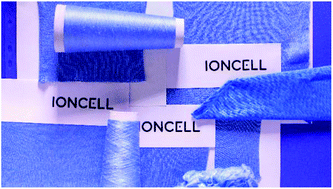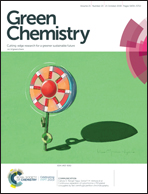Recycling of vat and reactive dyed textile waste to new colored man-made cellulose fibers†
Abstract
The successful recycling of colored textile waste and reuse of respective dyes would represent a major milestone of global efforts to reduce the environmental impact of the textile industry. The chemical upcycling of dyed pre- and postconsumer cotton waste is promoted by studying the spinability and color fastness of seven vat and reactive dyes (i.e. Indanthren Blue BC 3%, Indanthren Red FBB coll, Indanthren Brilliant Green FBB coll, Levafix Brilliant Red E-4BA, Levafix Blue E-GRN gran, Remazol Brilliant Blue R spec, and Remazol Black B 133%) during dry-jet wet spinning. Apart from the fabrics dyed with Levafix Brilliant Red E-4BA, all samples dissolved in 1,5-diazabicyclo[4.3.0]non-5-ene actetate, a superbase based ionic liquid, and could be converted to new colored man-made cellulose fibers. It was found that there is a clear discrepancy between the recyclability of dyed pre- and postconsumer cotton waste, resulting in significantly higher fiber properties up to tenacities of 59.8 cN/tex and elongations of 13.1% in case of the latter. All recycled fibers displayed a noticeable color change in the CIELab space (ΔE = 8.8–25.6) throughout the spinning process. Despite these deviations, almost all fibers and demo fabrics produced thereof exhibited bright colors that can be reused in textile industry. Only Remazol Black B 133% did not sufficiently translate to the new textile product. The wash and rubbing fastness of the fabrics knitted from the regenerated fibers was superior to the dyed waste fabrics mainly because of the homogenous distribution of the dyes along the fiber cross-section.



 Please wait while we load your content...
Please wait while we load your content...